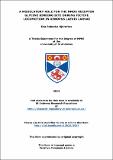Files in this item
A modulatory role for the NMDA receptor glycine binding site during fictive locomotion in Xenopus laevis larvae
Item metadata
| dc.contributor.advisor | Sillar, Keith T. (Keith Thomas) | |
| dc.contributor.author | Björnfors, Eva Rebecka | |
| dc.coverage.spatial | 84 p. | en_US |
| dc.date.accessioned | 2012-09-20T20:21:11Z | |
| dc.date.available | 2012-09-20T20:21:11Z | |
| dc.date.issued | 2012-06-20 | |
| dc.identifier.uri | https://hdl.handle.net/10023/3087 | |
| dc.description.abstract | This thesis follows up previous work carried out investigating the role of the NMDA receptor glycine site in fictive swimming in Xenopus laevis tadpole larvae. Extracellular glycine has been assumed to be present in the synaptic cleft at saturating levels, leaving no vacant NMDA glycine binding sites. D-serine, a ligand at the NMDA glycine binding site, has been found to increase the level of excitation in the CPG, increasing episode duration, increasing the occurrence of spontaneously occurring episodes, and producing more variation in burst frequency and amplitude within swim episodes leading to a waxing and waning pattern of swimming. These effects are also seen when glycine is co-applied with strychnine, and when glycinergic uptake is inhibited by the transporter blocker ALX. In this work, these findings have been confirmed and examined further by means of whole cell patch clamp recordings of spinal neurons of the CPG. D-serine causes a reversible increase in tonic depolarisation of spinal neurons along with a reversible decrease in spike height and an increase in spike frequency. D-serine also produces a paradoxical decrease in the membrane conductance and produces the above mentioned waxing and waning of swim episodes during which the neurons fire more or less intensely along with the waxing and waning. Furthermore, in the presence of TTX, bicuculline, and strychnine, D-serine increases the occurrence of miniature excitatory postsynaptic potentials. All of the above mentioned effects could be partially or fully reversed by either the NMDA receptor antagonist D-AP5 or the NMDA glycine binding site antagonist L-689560. In addition, D-serine could enhance NMDA-dependent intrinsic membrane potential oscillations, and in some experiments produce oscillations of a frequency reminiscent of oscillations dually dependent on NMDA and 5-HT. In conclusion, this work has shown that there are vacant glycine binding sites on NMDA receptors that can be bound by D-serine leading to an increase in overall excitation in the CPG. This is most likely achieved by tonic activation of NMDA receptors that is masked until the glycine site is occupied. | en |
| dc.language.iso | en | en_US |
| dc.publisher | University of St Andrews | |
| dc.rights | Creative Commons Attribution-NonCommercial-NoDerivs 3.0 Unported | |
| dc.rights.uri | http://creativecommons.org/licenses/by-nc-nd/3.0/ | |
| dc.subject | Tadpole | en_US |
| dc.subject | Modulation | en_US |
| dc.subject | Locomotion | en_US |
| dc.subject | NMDA | en_US |
| dc.subject.lcc | QP364.7B5 | en_US |
| dc.subject.lcsh | Methyl aspartate--Receptors | en_US |
| dc.subject.lcsh | Tadpoles--Locomotion | en_US |
| dc.subject.lcsh | Glycine | en_US |
| dc.subject.lcsh | Xenopus laevis | en_US |
| dc.title | A modulatory role for the NMDA receptor glycine binding site during fictive locomotion in Xenopus laevis larvae | en_US |
| dc.type | Thesis | en_US |
| dc.contributor.sponsor | University of St Andrews. Institute of Behavioural and Neural Sciences | en_US |
| dc.contributor.sponsor | University of St Andrews | en_US |
| dc.type.qualificationlevel | Doctoral | en_US |
| dc.type.qualificationname | MPhil Master of Philosophy | en_US |
| dc.publisher.institution | The University of St Andrews | en_US |
This item appears in the following Collection(s)
Except where otherwise noted within the work, this item's licence for re-use is described as Creative Commons Attribution-NonCommercial-NoDerivs 3.0 Unported
Items in the St Andrews Research Repository are protected by copyright, with all rights reserved, unless otherwise indicated.


